“KNOW, oh prince, that between the years when the oceans drank Atlantis and the gleaming cities, and the years of the rise of the Sons of Aryas, there was an Age undreamed of, when shining kingdoms lay spread across the world like blue mantles beneath the stars — Nemedia, Ophir, Brythunia, Hyperborea, Zamora with its dark-haired women and towers of spider-haunted mystery, Zingara with its chivalry, Koth that bordered on the pastoral lands of Shem, Stygia with its shadow-guarded tombs, Hyrkania whose riders wore steel and silk and gold. But the proudest kingdom of the world was Aquilonia, reigning supreme in the dreaming west. Hither came Conan, the Cimmerian, black-haired, sullen-eyed, sword in hand, a thief, a reaver, a slayer, with gigantic melancholies and gigantic mirth, to tread the jeweled thrones of the Earth under his sandaled feet.”
— The Nemedian Chronicles by Robert E. Howard
Robert Ervin Howard created worlds that flourished in reams of pulp fiction. The genre Sword and Sorcery can be traced to this introverted Texas wordmill. In spite of a well nourished melancholia, he invented a franchise for which he was never rewarded. The author lived by so many codes, the older ones got confused in a lonesome ethic only he could fathom. But the muscular sword swinging king of his fiction lives on, just as his creator predicted.
Howard was born January 24, 1906 in Peaster, Texas. His parents had braved the Western frontier in their own way. Issac Mordecai Howard was a rural doctor, moving his family from one small town to another. His wife, the former Hester Jane Ervin, was tubercular and frail. At 36 she bore their only child.
Hester grew disenchanted with her marriage. Her attachment to her son became her firmest reality. When she was terribly sick in 1912, 6-year-old Robert said that if she died, he would die too--a childhood sentimentality that she found charming.
From 1908 to 1918 the family resided in a number of tiny Texas towns including Seminole, Bronte, Wichita Falls, Bagwell, and Cross Cut. Young Robert was plagued by isolation and ill health. The last move came when he was 12 to a small house listed at $1,500 in Cross Plains, 40 miles southeast of Abilene. Here he would spend the rest of his life.
A voracious reader, printed pulp became his delivery system of choice. Superheroes who would appear in the Sunday funnies before muscling into comic books, i.e The Phantom, Superman, Batman, would not even exist until after his death.1 Howard devoured anything having to do with the Tarzan or the wild West and Texas history. Two of his favorites were outlaw John Wesley Hardin and Cynthia Ann Parker, the white child kidnapped and raised by the Comanches. As if to stir things even further, Howard’s father interested him in magic and the occult.
In 1920, when Robert was 14, the family spent six weeks in New Orleans where Dr. Howard completed an ophthalmology course. Robert secluded himself in libraries and museums, developing a fascination for the Picts, ancient Scottish aborigines.
In 1921, Howard acquired his first issue of the pulp zine Adventure (1910-1971). An English teacher urged him to submit a story which earned him his first rejection slip. To complete his final two grades of high school, Howard and his mother moved to nearby Brownwood. Here he was first published in The Tattler student newspaper. After graduating in 1923, Howard decided against further formal education. He would read what he pleased and concentrate on body building.
Enduring a series of low paying long-hour jobs, Howard wrote late into the night. His self-addressed envelopes returned with prompt regularity. In 1925, using skills he picked up in a typing class at Howard Payne College, he made his first commercial sale, the Neanderthal adventure "Spear and Fang," to Weird Tales (1923-1954). For 3,400 words, he received $17.
Attempts to sell Westerns and sports stories received lukewarm editorial response. After revision, Weird Tales bought “The Lost Race,” a tale of the Bronze Age and hero Bran Mak Morn, for $30 in 1927. To supplement his income, he filed reports from the Texas and Oklahoma oil fields to regional newspapers, averaging about $25 a month for his crude insights.
On the surface, Howard’s literary career appeared most doomed. Brief stays at the Cross Plains Post Office and a natural gas company were his next day jobs, while he worked late into the full moon evenings on a werewolf serial. In 1926, he was a drugstore soda jerk. The long work day convinced him to return to school that autumn for a course in bookkeeping.
In August of 1929, two months before the stock market crashed, Howard sold “The Shadow Kingdom” to Weird Tales. It starred Kull, king of ancient Atlantis, born in 100,000 BC. In Howard's world, men were men, women were trophies, and battles were won by the sword. Full throttle violence and magic mingled at the core of his fantasy.
After completing the novella “Skull-Face," Howard slugged his way into another market, selling boxing stories to various publications. Writing money earned that year totaled $750 ($12,000 in 2021 dollars.)
By 1932, he had invented the Hyborian Age. A savage time such as this demanded an over-the-top hero. The first story in the series, “The Phoenix on the Sword," appeared in Weird Tales that December. It probably didn’t feel like it, but Howard’s newest character, Conan the Barbarian, would become his greatest and most memorable creation.
“Some mechanism in my subconsciousness took the dominant characters of various prizefighters, gunmen, bootleggers, oil field bullies, gamblers, and honest workmen I had come in contact with, and combining them all, produced the amalgamation I call Conan the Cimmerian” —Robert Howard
Of the 21 Conan adventures that Howard would crank out over the next four years, 17 were in that magazine. Conan the mighty and violent hacked his way through such tales as "The Scarlet Citadel" and “A Witch Shall Be Born."
As Howard’s literary career finally gathered steam, his private and highly personal life remained unusual. A brief romance sputtered. It seems to have ended when it became evident that Howard would never be able to detach himself from his sickly mother.
During the winter of 1935-36, he wrote and sold five westerns to Argosy (1882-1978). Success in the saddle made him consider switching to oaters for good. Zane Grey was doing well, outselling F. Scott Fitzgerald. The Conan stories were popular, but Howard longed to broaden his audience and, in so doing, increase his income.
Wildly creative, the self-taught Howard carried on correspondences with major writers who plunged headlong into darkness including H. P. Lovecraft, whose white supremacy leanings leaked into his fiction. The Cthulhu Mythos author argued that civilization was man's greatest accomplishment. The broody Texan fired back that when all was said and done, the barbarians would emerge victorious, the heads of philosophers on the tent poles of warriors.
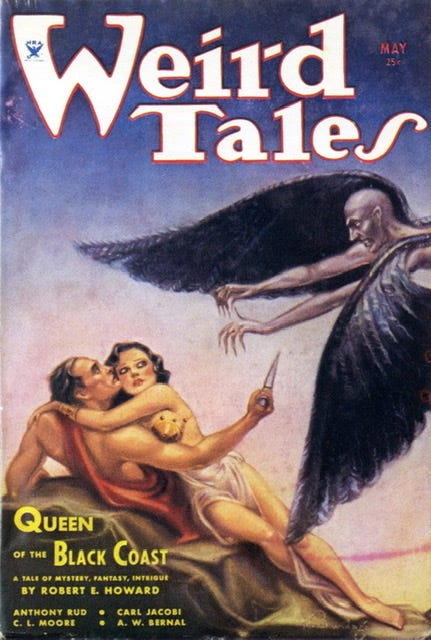
As his career merged into a faster lane, he could not escape the gravitational pull of his family life. Following an early summer decline, his frail mother slipped into a coma. Her distraught son remembered his unsettling promise of so many years before.
On June 11, 1936, in their modest Texas home, the 30-year-old writer kept a tearful, nightlong vigil at his mother’s bedside. As the sun came up, Howard realized what lay ahead, and it was too much. Quietly he got up, typed a brief poem in his room, and walked toward the garage and their 1931 Chevy sedan. He took a Colt automatic pistol from the glove box, held it to his head, and put a bullet through his imagination.
Howard never regained consciousness and passed eight hours later. Mrs. Howard lived another day. Mother and son were interred in a double ceremony at Brownwood's Greenleaf Memorial Cemetery on June 14. His estate was appraised at $2,902. Overall, his output totaled some 800 short stories and fragments, and around 500 poems.
In 1950, the Gnome Press began reprinting Howard's stories in book form, the first being Conan the Conqueror. Other fantasy scribes contributed to the saga but, as one critic noted in reference to Howard the Originator, “None of them is as crazy as he was."
Conan became a staple of the paperback science fiction market and in 1982 made it to the big screen. The warrior with few words and tons of muscle was portrayed by Arnold Schwarzenegger in Conan the Barbarian (1982) and Conan the Destroyer (1984), followed in the new millennium by Jason Momoa in Conan the Barbarian (2011).
Neil Barron's science fiction bibliography Anatomy of Wonder (1976) maintains that "the Conan books are racist, sexist trash which combine a simpering sexuality with thud-and-blunder adventure." Author L. Sprague de Camp, along with Catherine Crook de Camp and Jane Whittington Griffin in their definitive bio, Dark Valley Destiny: The Life of Robert E. Howard (1983) note, "Conan is the prototype of man against the universe--a hero who is dauntless against mortal enemies but withal fearful of unseen sinister forces beyond the control of powerful arm."
Robert Howard’s legacy is complicated. Suicides don’t attain role model status. Beyond Conan, Howard created a team of macho loner anti-heroes as he tried to ensnare a genre to call his own. Among them: adventurer Solomon Kane, Red Sonya of Rogatino, John Kirowan the occult scholar, El Borak the Scottish/Irish gunslinger of Afghanistan, Bêlit the pirate queen, ‘the wildest she-devil unhanged’, Sailor Steve Costigan the bard of the boxing ring, Breckenridge Elkins the wild Western wit, and Dark Agnes de Chastillon, whose first comic book appeared in 2019.
Conan remains indestructible. His brawn and willpower moved all the various tribes of the Howard pulp kingdoms into the next millennium. Many talents from film, print, and gaming took up the sword of the troubled master. Images of great serpents, skull masks of evil, and blood splashing in every direction were inspirational objects for artists of the post-nuclear age. Comics were a natural evolution, first with Marvel (650 issues, 1970-2000), then for 15 years with Dark Horse.
In 2018, the Marvel Cinematic Universe announced it had reacquired the Conan franchise. “We’re thrilled to be working with Marvel and look forward to the new adventures in store for Conan,” president of Conan Properties International Fredrik Malmberg said in a statement in the Hollywood Reporter. “As the most well-known and creative publisher in the industry, we think Marvel is a great fit for our stories.” The first of the new comics appeared in 2019, and at the time of the global pandemic, talks were underway for The Legend of Conan becoming a bloodthirsty binge-worthy television series.
The most famous resident of the Hyborian Age fought against evil most foul, swinging weighty swords amidst mind bending sorcery. Conan the Cimmerian again seems poised to become a “hero for our times,” regardless of who adorns his tent poles.
Robert E. Howard was a talented bundle of neuroses and extremes whose delusions galloped away with him. His gift, as well as his downfall, was escape. In so doing, he created fantastic fictions, but in a penny-a-word world, he found a future he chose not to attend.
Technically The Phantom first appeared in daily newspaper strips on Feb 17, 1936, four months before Mr. Howard’s demise. It is doubtful Howard ever saw the character, much less receive any kind of inspiration. “The ghost who walks” did not transcend to the Sunday color strips until May 28, 1939, via the King Features Syndicate. Superman arrived in his baby rocket in Action Comics #1, published by D.C. on April 18, 1938. The character was first created in 1933 by high school action nerds Jerry Siegel and Joseph Shuster, so it is much more likely that Conan was an influence on the last son of Krypton than the other way around.

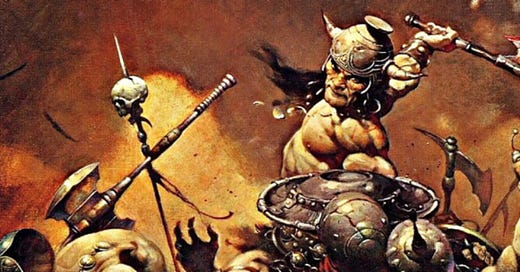



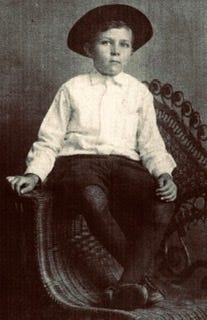
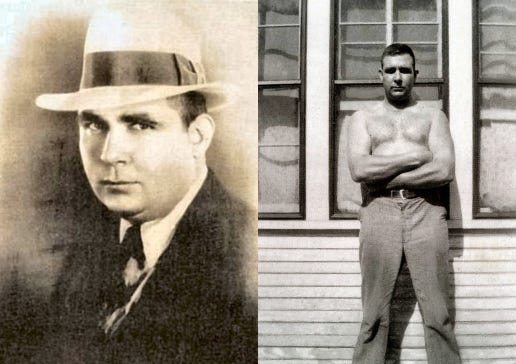
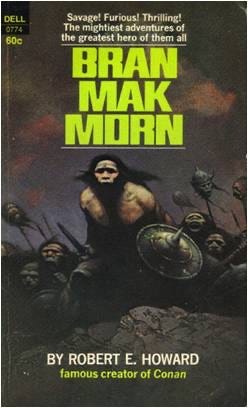
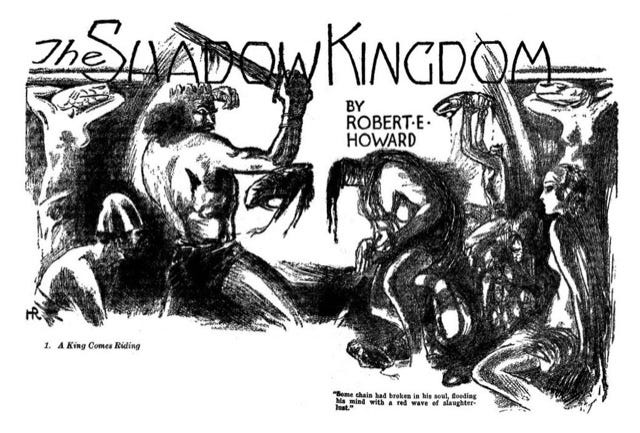
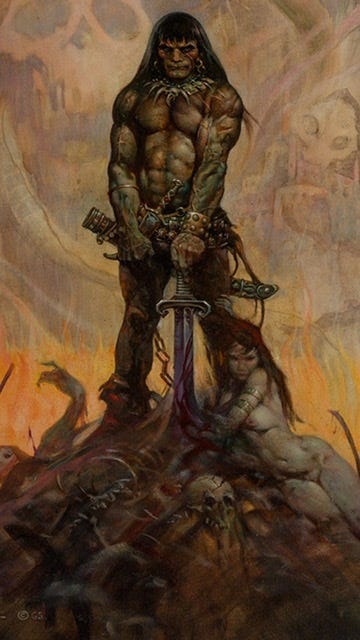
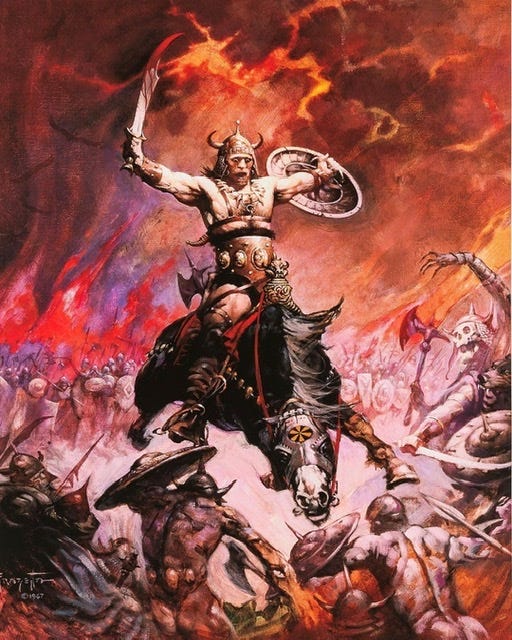
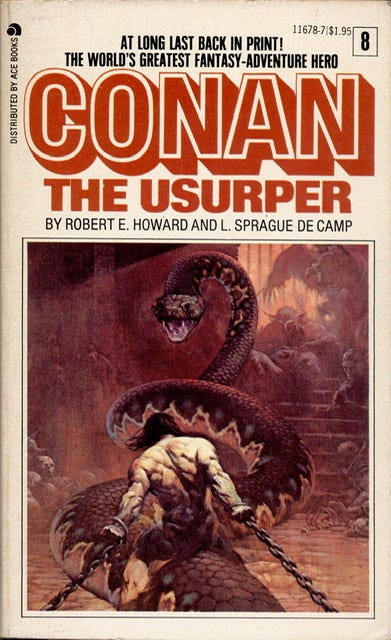
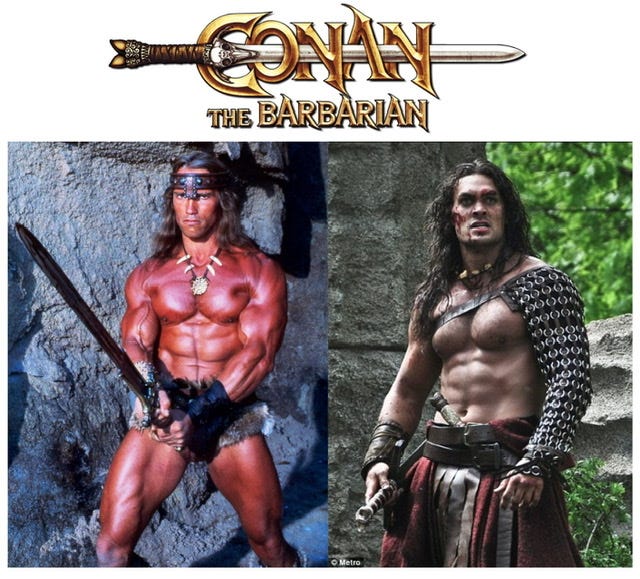
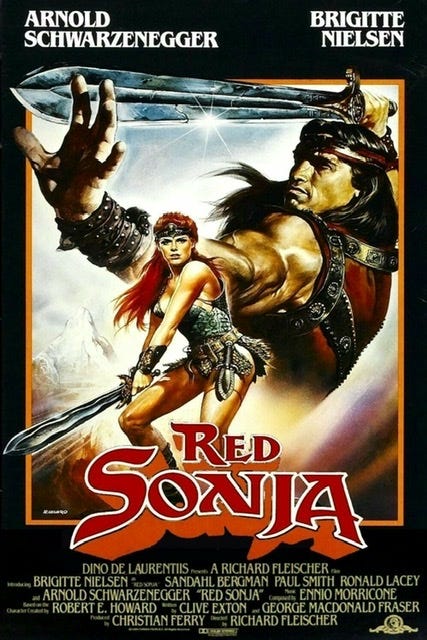
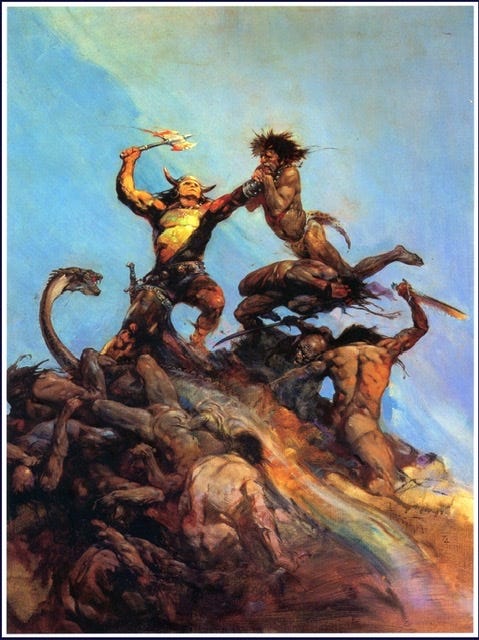
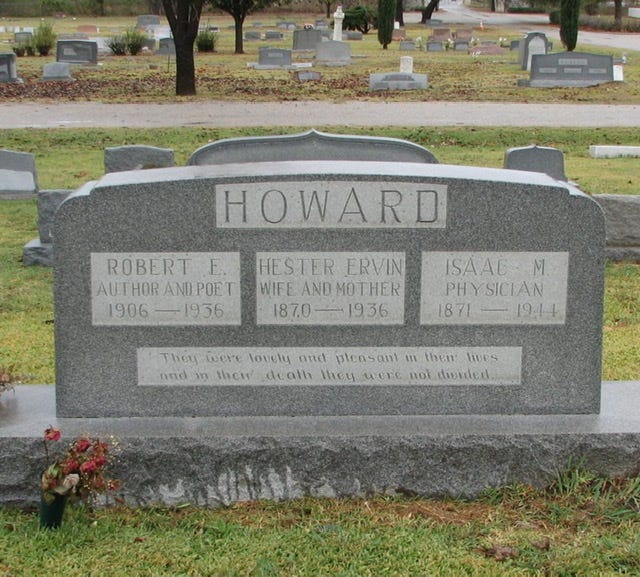
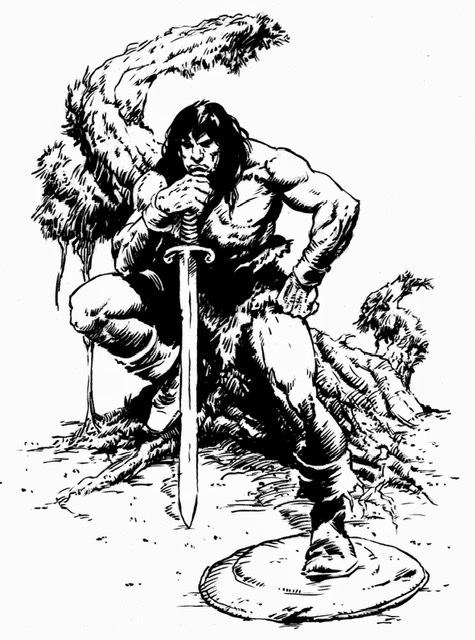
Good one!